Students can Download 2nd PUC Physics Model Question Paper 4 with Answers, Karnataka 2nd PUC Physics Model Question Papers with Answers helps you to revise the complete Karnataka State Board Syllabus and score more marks in your examinations.
Karnataka 2nd PUC Physics Model Question Paper 4 with Answers
Time: 3 Hrs 15 Min
Max. Marks: 70
General Instructions:
- All parts are compulsory.
- Answers without relevant diagram/figure/circuit wherever necessary will not cany any marks
- Direct answers to the Numerical problems without detailed solutions will not carry any marks.
Part – A
I. Answer all the following questions ( 10 × 1 = 10 )
Question 1.
State Ohm’s law.
Answer:
Ohm’s Law-At constant temperature the current through a conductor is directly proportional to the potential difference between its ends.
Question 2.
Define current sensitivity of a galvanometer.
Answer:
Deflection per unit current is called current Sensitivity.
Question 3.
Write the expression for force experienced by a straight conductor of length L carrying a steady current I, moving in a uniform external magnetic field B.
Answer:
![]()
![]()
Question 4.
What is ‘retentivity’ in magnetism?
Answer:
Retaining the magnetism even after the removal of the magnetising field is called retentivity.
Question 5.
Where on the earth’s surface is the magnetic dip zero?
Answer:
At magnetic equator dip is zero. ,
Question 6.
State ‘Lenz’s law in electromagnetic induction.
Answer:
The polarity of induced emf is such that it tends to produce a current which opposes the Change in magnetic flux that produced it.
Question 7.
Write the condition for ‘resonance’ of series LCR circuit.
Answer:
inductive reactance = capacitive reactance XL = Xc
Question 8.
What is ‘wattless’ current?
Answer:
In purely inductive or capacitive circuit, no power is dissipated even though a current is flowing in the circuit. This current is called wattles current.
Question 9.
Write any one advantage of light emitting diode.
Answer:
Frequency remains constant.
![]()
Question 10.
What is attenuation in communication system?
Answer:
Mass number of the daughter nuclide 234
Part – B
II. Answer any Five of the following questions. ( 5 × 2 = 10 )
Question 11.
Represent graphically the variation of resistivity with absolute tempera ture for copper and nichrome metals.
Answer:
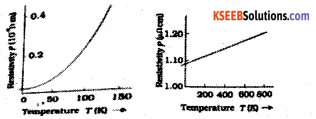
Question 12.
Write the expression for cyclotron frequency and explain the terms.
Answer:
Vc = \(\frac{\mathrm{qB}}{2 \pi \mathrm{m}}\)
q- Charge B- magnetic field
m-mass of the charged particle
Vc = cyclotron frequency
Question 13.
State and explain ‘curie’s Law’ in magnetism.
Answer:
The magnetic susceptibility ( χ ) of a para magnetic substance is inversely proportional to the absolute temperature (T).
χ = \(\mathrm{C} \frac{\mu_{0}}{\mathrm{T}}\)
C – Curie constant.
![]()
Question 14.
Mention any two factors on which the self inductance of a coil depends.
Answer:
Self-inductance of a coil depends on
- number of turns of the coil
- area of cross section and length (geometry)
- permeability of the medium
Question 15.
Give any two application of ultraviolet radiations.
Answer:
- used in LASIK eye surgery
- UV lamps are used to kill germs in water purifiers
- Disinfection for virus and bacteria
- To produce photo electric current in burglar alarm.
Question 16.
What is polarisation of light? Name any one method of producing plane polarised light.
Answer:
The phenomenon of confining the vibrations of light in a single plane is called polarisation. Reflection / scattering.
Question 17.
Calculate de Broglie wavelength associated with an electron moving with a speed of 2 × 105 ms–1 . Given h = 6.625 × 10–34JS, me = 9.11 × 10–31kg.
Answer:

![]()
Question 18.
Write any two advantages of Light Emitting Diode (LED) over conventional in candescent low power lamps.
Answer:
Advantages of LED
- Low operational voltage and less power consumption
- Fast action and no warm up time required
- Long life and ruggedness
- Fast on-off switching capability
Part – C
III. Answer any five of the following questions. ( 5 × 3 =15)
Question 19.
Give any three properties of electric field lines.
Answer:
Properties electric field lines.
- Field lines starts from positive charges and end at negative charges.
- In a charge free region electric field lines can be taken to be continuous curves without any breaks.
- Two field lines can never cross each other.
- Electrostatic field lines do not form any closed loops.
Question 20.
Obtain the expression for effective capacitance of two capacitors connected in series.
Answer:

Let c1,c2 -capacitance of 2 capacitors connected in series
Q-charge on each capacitor
V1 V2-pd across C1 and C2
V-Total voltage drop across the combination
Then V = V1 + V2 ……… (1)
Also Q = CV
V1 = \(\frac{\mathrm{Q}}{\mathrm{C}_{1}}\) and V2 = \(\frac{\mathrm{Q}}{\mathrm{C}_{2}}\)
If system of capacitors is replaced by a single capacitor of equivalent capacitance cs then
Vs = \(\frac{\mathrm{Q}}{\mathrm{C}_{\mathrm{s}}}\)

Question 21.
Write any three differences between diamagnetic and paramagnetic materials.
Answer:
| Diamagnetic | Paramagnetic |
| 1. Weakly magnetised in a direction opposite to the applied magnetic field | 1. Weakly magnetised along the direction of the applied magnetic field. |
| 2. Move from stronger to weaker part of the external magnetic field | 2. Move from weaker to the stronger part of the external magnetic field |
| 3. Magnetic susceptibility is Low and negative | 3. Magnetic susceptibility is low and positive. |
| 4. Example: Bismuth, copper, lead, silicon | 4. Example: Aluminium, sodium, calcium, oxygen |
Question 22.
Describe the col and barmagnet experiment to demonstrate the phenomenon of electromagnetic induction.
Answer:
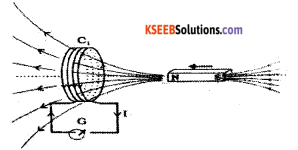
Coil and bar magnet experiment In the figure coil C1 is connected to a galvanometer G
- when N-pole of the bar magnet is pushed towards the coil, there is a momentary deflection in the galvanometer.
- when the magnet is pulled away from the coil galvanometer shows momentary deflection in the opposite direction.
- Faster movements result in a larger deflection.
- But no deflection when the coil and magnet are stationary with respect to each other. Or no deflection when there is no relative motion.
Therefore it shows that the relative motion between the magnet and coil induces electric current.
Question 23.
Derive the expression for effective focal length of two thin lenses kept in contact.
Answer:
Let f1= focal length of first lens, and
f2 = focal length of second lens
OP = u= object distance
PI = v = image distance due to the combination
PI1 = v1 = image distance due to first lens
For the image formed by lens A,
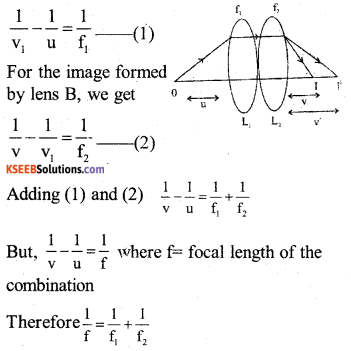
![]()
Question 24.
Write any three experimental observations of photoelectirc effect.
Answer:
- The photoelectric emission is an instantaneous process, even when incident radiation is exceedingly dim.
- Above threshold frequency, the photo current is directly proportional to the intensity of incident radiation.
- Above the threshold frequency, saturation current is proportional to the intensity
of the incident radiation and stopping potential is independent of intensity. - There exists a certain minimum cut-off frequency called ‘threshold frequency’ below which no photo emission however intense the incident beam.
- Above threshold frequency the kinetic energy of the photo electrons is directly proportional to the frequency of incident radiation and is independent of intensity.
Question 25.
How zener diode is used as a voltage regulator? Explain.
Answer:
Zener diode as a voltage regulator
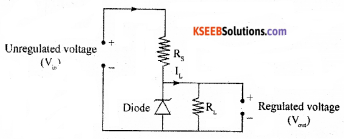
The circuit connections are made as shown in the figure. The Zener diode is reverse biased. If the unregulated input voltage increases, the current through Rs and Zener diode also increases. This increases the voltage drop across Rs without any change in the voltage across the Zener diode. This is because in the breakdown region Zener voltage remains constant even though the current through Zener diode changes.
Similarly, if the input voltage decreases, the current through Rs and Zener also decreases. So, any increase or decrease of input results in increase or decrease of voltage drop across Rs without change in voltage across Zener diode. Hence it acts as a voltage regulator.
Question 26.
What is the function of ‘receiver’ in communication system? Draw the block diagram of AM – receiver.
Answer:
A receiver extracts the desired message signals from the received signals at the channel output.

Part – D
IV. Answer any two of the following questions ( 2 × 5 = 10 )
Question 27.
Using Gauss’s law in electrostatics, obtain the expression for electric field due to a uniformly charged thin spherical shell at a point
i. outside the shell and
ii. inside the shell
Answer:
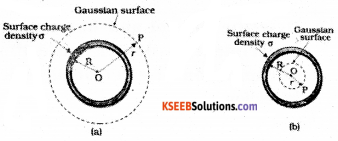
Let σ be the uniform surface charge density of a thin spherical shell of radius R Field outside the shell.
Consider a point P outside the shell at a distance r from the centre of the shell. Imagine a gaussian sphere of radius ‘r’ The electric flux at P due to surface ∆ S is
∆φ= \(\overrightarrow{\mathrm{E}} \cdot \overrightarrow{\Delta \mathrm{S}}\) = E∆S COSθ=E∆S {COS θ=1}
Total electric flux due to the sphere is
φ = E4πr2 ……….(1)
From Gauss law the electric flux

where q= total charge enclosed by the surface From (1) & (2)

b) electric field inside shell E = 0
![]()
Question 28.
Derive σ = \(\frac{\mathrm{ne}^{2} \tau}{\mathrm{m}}\) Where the symbols have their usual meaning.
Answer:

Consider conductor of length ∆x, area of cross section A.
Vd-drift speed of free electrons, in a time ∆ t, let all the electrons travel a distance ∆ x = Vd ∆ t.
Electric current I = ∆Q /∆t = neAvd
The acceleration acquired by the free electrons is given by a = \(\frac{-\mathrm{eE}}{\mathrm{m}}\)
where m= mass of the electron
If τ = relaxation time then velocity
vd = \(\frac{-e E}{m} \tau\)

Current density J = \(\frac{1}{\mathrm{A}}\), J = σE therefore
σ = \(\frac{n e^{2} \tau}{m}\)
Question 29.
Obtain expression for the force between two infinitely long straight parallel conductros carrying current. Hence define ‘ampere’ the SI unit of electric current.
Answer:
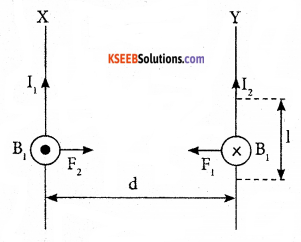
Consider two infinitely long straight conductors a & b carrying currents Ia & Ib respectively are separated by a distance ‘d’. The conductor ‘a’ produces the same magnetic field Ba at all points along the conductor ‘b’.
Ba = \(=\frac{\mu_{0} I_{a}}{2 \pi d}\) …………( 1 )
The conductor ‘b’ experiences a force Fba
Fba = BaLIb = \(=\frac{\mu_{0} I_{a} I_{b} L}{2 \pi d}\)
where L= length of the conductor

Similarly one can show that Fba = -Fab
(A) ampere- The currents flowing through two infinitely long parallel conductors separated by 1m distance is 1 ampere if they experience a force of 2 X 10–7N per unit length in air or vacum.
V. Answer any two of the following questions ( 2 × 5 = 10 )
Question 30.
Derive the expression for the fringe width of interference pattern in Young’s double-slip experiment.
Answer:
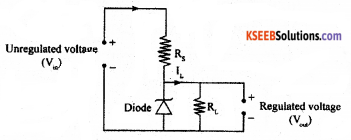
S1 & S2 are two coherent sources. GG| – screen at a distance D from the sources.
Let d = distance between the slits (two sources).
P = a point at a distance from the middle of the screen where a bright fringe is formed.
For constructive interference path difference = nλ
S2P – S1P = nλ where n = 0,1,2,3…….
From the diagram

(S2P )2 – (S1P )2=2xd
(S2P – S1P)(S2P + S1P) = 2xd
S2P ≅ S1P ≅ OP = D
S2P – S1P = \(\frac{\mathrm{xd}}{\mathrm{D}}\) = nλ
Xn = \(\frac{\mathrm{n} \lambda \mathrm{D}}{2}\)
Where n = 0, +1, ±2, ± 3 for bright fringes
±1, ±2, ±3 for dark fringes
Since the finges are equally spaced the distance between two consecutive bright or consecutive dark fringes gives finge width.

β = \(\frac{\lambda \mathrm{D}}{\mathrm{d}}\)
![]()
Question 31.
Describe with suitable block diagra ms, action of pn-junction diode under forward and reverse bias conditions. Also draw I-V characteristics.
Answer:
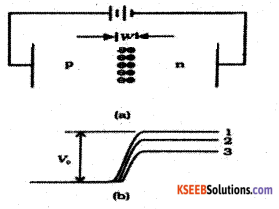
PN Junction diode under forward bias.
When the diode is forward biased as shown in the figure the depletion region width decreases and the barrier height is reduced. The electrons from n-side cross the depletion region and reach p-side also holes from p-side cross the junction and reach the n-side. A concentration gradient is developed at the junction boundary. Due to this the motion of charged carriers on either side gives rise to current. The total diode forward current is sum of hole diffusion current and conventional current due to electron diffusion.
PN Junction diode under reverse bias
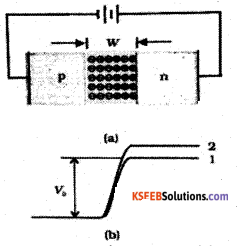
When the diode is reverse biased the depletion region width increases and the barrier height is increased. This supresses the flow of electrons from n-side to p-side and holes from p-side to n-side. Thus, diffusion current decreases. The conventional current is due to drift of the minority charge carriers which is of the order of micro amperes. The current under reverse bias is voltage independent up to a critical reverse bias voltage known as breakdown voltage.
The I-V characteristics are as shown.
VI Characteristics
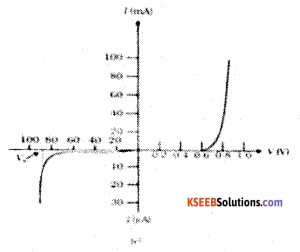
Question 32.
Assuming the expression for the radius of electron orbit, obtain the expression for the total energy of the electron in the stationary orbit of hydrogen atom.
Answer:
The radius of the electron orbit is given by r = \(=\frac{\varepsilon 0 n^{2} h^{2}}{\pi m e^{2}}\)
Total energy E of the electron in a hydrogen atom is the sum of kinetic energy K and potential energy U
E=K+U
The electrostatic force of attraction between the revolving electrons and the nucleus is balanced by centripetal force in a dynamically stable orbit of hydrogen atom.
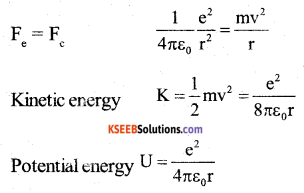
(negative sign signifies that the electrostatic force is in the – r direction)
The total energy of the electron in a hydrogen atom is

![]()
VI. Answer any three of the following question ( 3 × 5 = 15 )
Question 33.
The plates of a parallel plate capacitor have an area of 100 cm2 each of 100 cm2 each and are separated by 3 mm. The capacitor is charged by connecting it to a 400 V supply.
a) Calculate the electrostatic energy stored in the capacitor.
b) If a dielectric of dielectric constant 2.5 is introduced between the plates of the capacitor, then find the electrostatic
Answer:
energy stored and also change in the energy stored.
Given A = 100 cm2 = 100 x 10–4m2,
d = 3 mm = 3 x 10–3m, V = 400 V, U1 =?
K = 2.5,U2 = ? also U2 – U1=?
U = \(\frac{1}{2} \mathrm{CV}^{2}\) C = \(\frac{\varepsilon_{0} \mathrm{A}}{\mathrm{d}}\)
Calculating
U1 = 23.608 x 10–7J
U2 = 59.02 x 10–7J
U2∼U1 = 35.412 x 10–7J
Question 34.
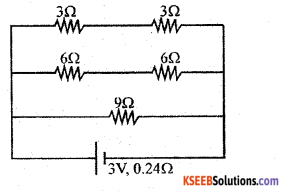
In the given circuit diagram, calculate : (i) The main current through the circuit and (ii) Also current through 9 Ω resistor.
Answer:
RS = R1 + R2

Calculating the value of effective resistance R = 2.76 Ω

Current through 9 Ω= 0.308A
Question 35.
A 20 Ω resistor; 1.5 H inductor and 35 μF capacitor are connected in series with a 220 V, 50 Hz ac supply, calculate the impedance of the circuit and also find the current through the circuit.
Answer:
R = 20Ω, L= 1.5 H, C = 35 x 10–6F,
V = 220V, v=50Hz, Z=?, I=?
![]()
XL = wL=2πvL = 471 Ω

Calculation of Z = 380.53 Ω
I = \(\frac{v}{z}\) = 0.578A
Question 36.
The radii of curvature of two surfaces of a convex lens is 0.2 m and 0.22 m. find the focal length of the lens of refractive index of the material of lens is 1.5. Also find the change in focal length, if it is immersed in water of refractive index 1.33.
R1=0.2m, R2=–022m, n8=1.5, fair=?
fwater =?, fair~fwater =? nw=1.33

Substituting the values, and calculating f = 0.209 m. Calculating focal length when immersed in water fwater=0.819
change in focal length = 0.61m
![]()
Question 37.
The half life of a radioactive sample 38Sr90 is 2 years. Calculate the rate of disintegration of 15 mg of this isotope.
Given Avogadro number = 6.023 x 1023.
Answer:
T1/2 = 28 years = 28 x 365 x 24 x 600 = 8.83 x 108 seconds
90g \(\mathrm{Sr}_{38}^{90}\) contains 6.023 x 1023 atoms
λ = \(\frac{0.693}{T_{1 / 2}}\)
Decay constant λ =7.85 x 1010 x 1.004 x 1.004 × 1010
Rate of disintegration R= λ N
R = 7.88 x 1010 Bq